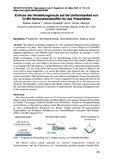Zitierlink:
http://dx.doi.org/10.25819/ubsi/10400Dateien zu dieser Ressource:
| Datei | Beschreibung | Größe | Format | |
|---|---|---|---|---|
| Stennei_Einfluss_der_Herstellungsroute.pdf | 693.79 kB | Adobe PDF |  Öffnen/Anzeigen |
| Dokumentart: | InProceedings | Titel: | Einfluss der Herstellungsroute auf die Umformbarkeit von Cr-Mn-Verbundwerkstoffen für das Presshärten | AutorInn(en): | Stennei, Markus Grodotzki, Joshua Tekkaya, A. Erman |
Institut: | Institut für Produktionstechnik | Schlagwörter: | Presshärten, Wärmebehandlung, Verbundwerkstoffe, Biegeversuche | DDC-Sachgruppe: | 620 Ingenieurwissenschaften und zugeordnete Tätigkeiten | GHBS-Notation: | ZIR | Erscheinungsjahr: | 2023 | Publikationsjahr: | 2023 | Auch erschienen: | Engel, Bernd (Hrsg.): Transformation in der Biegetechnik : Tagungsband zum 6. Biegeforum Siegen : 24.-31. März 2023. Siegen: universi - Universitätsverlag Siegen, 2023. - ISBN 978-3-96182-155-6 - DOI http://dx.doi.org/10.25819/ubsi/10365, S. 115-122 | Zusammenfassung: | The analysis of bending properties of a new composite material for press hardening is presented in this paper. This composite material consists of a boron-Magan core (22MnB5) and a stainless-steel cover layer. The core material is the typical press hardening material for industrial applications. Two different types of top layer are considered, an austenitic (1.4301) and a martensitic (1.4021) stainless steel. Initial investigations have shown that the manufacturing of the roll clad semi-finished product leads to low the formability of the cover layer materials. In this analysis, different heat treatment strategies have been added to the process route and their influence on the formability is investigated. For this purpose, a 3-point bending test with optical strain measurement system is developed. The test setup allows the accurate determination of the strain at failure of the cover layer at room temperature. It is shown that neither heat treatment after hot rolling nor intermediate annealing during cold rolling improves formability. The highest degree of forming on the outer bend is obtained with a process route without heat treatment. Even in this particular case, the remaining formability is about 50 % lower compared with the values achieved by the untreated material of the cover layer. No reduction in bond strength due to heat treatment was observed. The formability results indicate that further analysis of the entire process chain and the associated diffusion processes is necessary to understand the remaining underperformance of the composite material. |
DOI: | http://dx.doi.org/10.25819/ubsi/10400 | URN: | urn:nbn:de:hbz:467-26120 | URI: | https://dspace.ub.uni-siegen.de/handle/ubsi/2612 | Lizenz: | http://creativecommons.org/licenses/by-sa/4.0/ |
| Enthalten in den Sammlungen: | Universi |
Diese Ressource ist urheberrechtlich geschützt. |
Seitenansichten
243
checked on 25.11.2024
Download(s)
74
checked on 25.11.2024
Google ScholarTM
Prüfe
Prüfe
Diese Ressource wurde unter folgender Copyright-Bestimmung veröffentlicht: Lizenz von Creative Commons


